MGT602: Analysis of Individual and Group Decision Making Processes
VerifiedAdded on 2022/08/17
|15
|3343
|9
Report
AI Summary
This report provides a comprehensive analysis of individual and group decision-making processes within an organizational context. It begins by highlighting the importance of decision-making in business management and then delves into the role of data analytics and visualization in supporting effective decisions. The report explores various types of data analytics, including descriptive, diagnostic, predictive, and prescriptive analytics, and explains how they contribute to evidence-based decision-making. It also examines the significance of data visualization in facilitating the analysis and communication of information. Furthermore, the report discusses a range of decision-making tools and techniques, such as market research, cost-benefit analysis, and SWOT analysis, and their applications in strategic human resource management. The analysis covers topics such as data analytics, data visualization, and decision-making tools like market research and SWOT analysis. This report aims to provide a detailed overview of decision-making processes and the tools used to support them.

Running Head: INDIVIDUAL AND GROUP DECISION MAKING PROCESSES
INDIVIDUAL AND GROUP DECISION MAKING PROCESSES
Name of the Student
Name of the University
Author Note:
INDIVIDUAL AND GROUP DECISION MAKING PROCESSES
Name of the Student
Name of the University
Author Note:
Paraphrase This Document
Need a fresh take? Get an instant paraphrase of this document with our AI Paraphraser
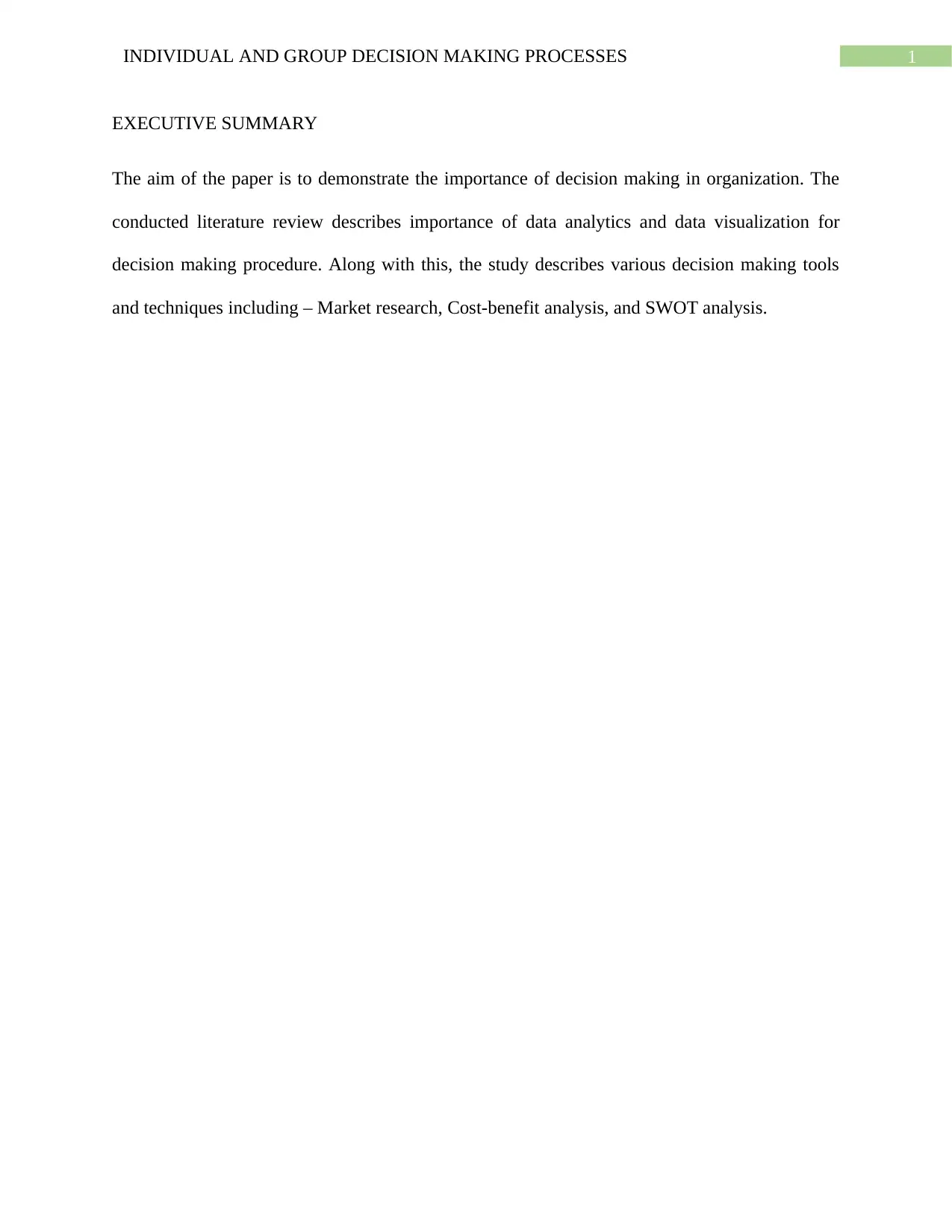
1INDIVIDUAL AND GROUP DECISION MAKING PROCESSES
EXECUTIVE SUMMARY
The aim of the paper is to demonstrate the importance of decision making in organization. The
conducted literature review describes importance of data analytics and data visualization for
decision making procedure. Along with this, the study describes various decision making tools
and techniques including – Market research, Cost-benefit analysis, and SWOT analysis.
EXECUTIVE SUMMARY
The aim of the paper is to demonstrate the importance of decision making in organization. The
conducted literature review describes importance of data analytics and data visualization for
decision making procedure. Along with this, the study describes various decision making tools
and techniques including – Market research, Cost-benefit analysis, and SWOT analysis.
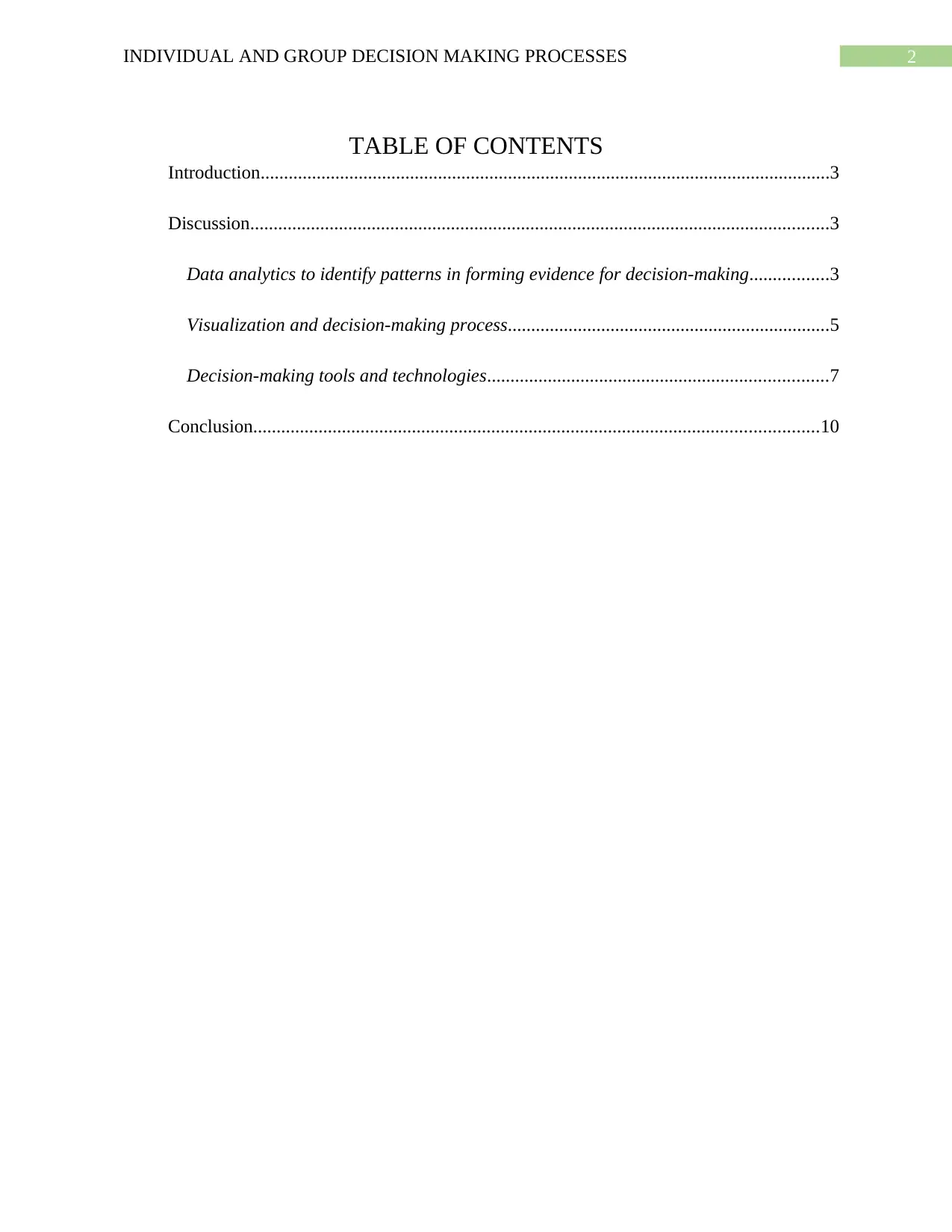
2INDIVIDUAL AND GROUP DECISION MAKING PROCESSES
TABLE OF CONTENTS
Introduction..........................................................................................................................3
Discussion............................................................................................................................3
Data analytics to identify patterns in forming evidence for decision-making.................3
Visualization and decision-making process.....................................................................5
Decision-making tools and technologies.........................................................................7
Conclusion.........................................................................................................................10
TABLE OF CONTENTS
Introduction..........................................................................................................................3
Discussion............................................................................................................................3
Data analytics to identify patterns in forming evidence for decision-making.................3
Visualization and decision-making process.....................................................................5
Decision-making tools and technologies.........................................................................7
Conclusion.........................................................................................................................10
⊘ This is a preview!⊘
Do you want full access?
Subscribe today to unlock all pages.

Trusted by 1+ million students worldwide
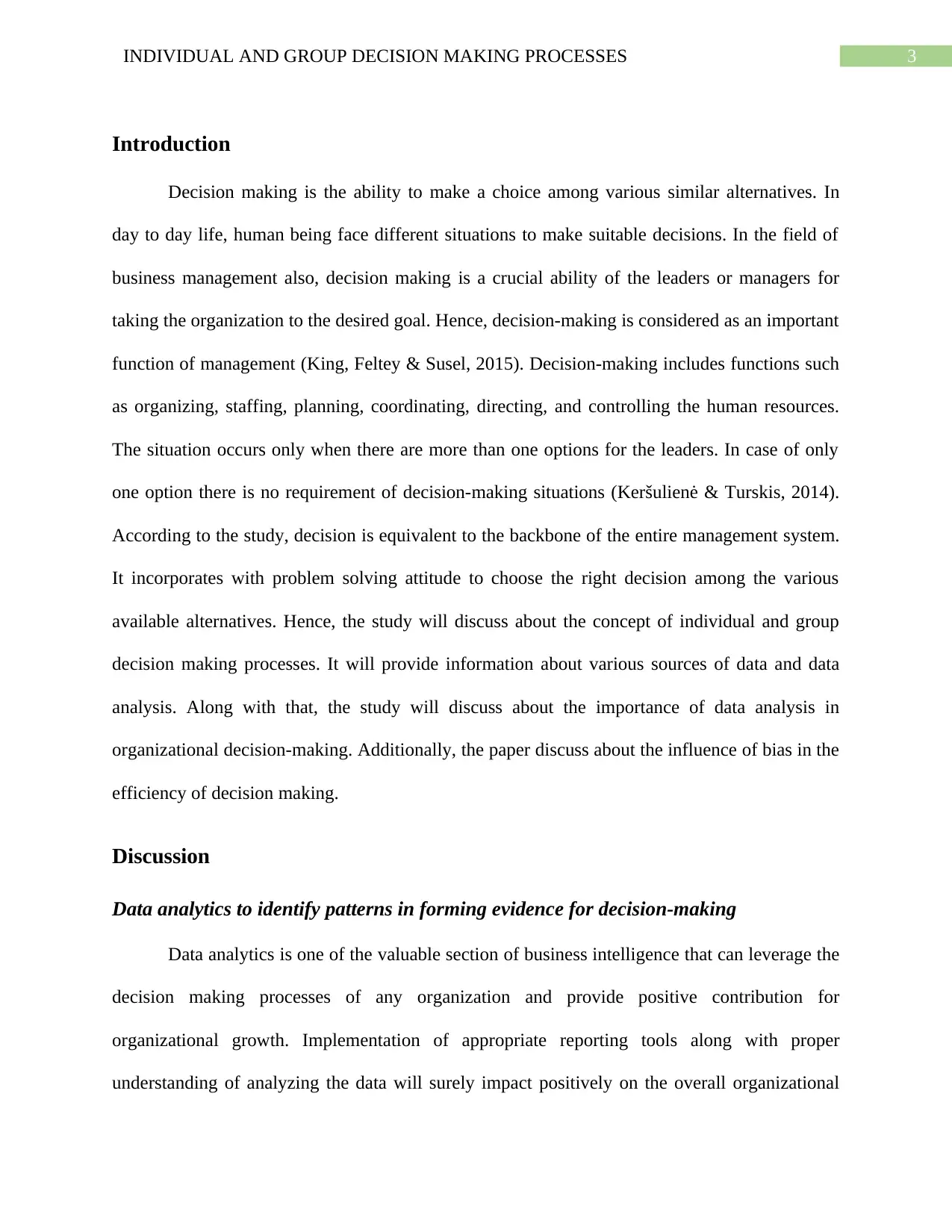
3INDIVIDUAL AND GROUP DECISION MAKING PROCESSES
Introduction
Decision making is the ability to make a choice among various similar alternatives. In
day to day life, human being face different situations to make suitable decisions. In the field of
business management also, decision making is a crucial ability of the leaders or managers for
taking the organization to the desired goal. Hence, decision-making is considered as an important
function of management (King, Feltey & Susel, 2015). Decision-making includes functions such
as organizing, staffing, planning, coordinating, directing, and controlling the human resources.
The situation occurs only when there are more than one options for the leaders. In case of only
one option there is no requirement of decision-making situations (Keršulienė & Turskis, 2014).
According to the study, decision is equivalent to the backbone of the entire management system.
It incorporates with problem solving attitude to choose the right decision among the various
available alternatives. Hence, the study will discuss about the concept of individual and group
decision making processes. It will provide information about various sources of data and data
analysis. Along with that, the study will discuss about the importance of data analysis in
organizational decision-making. Additionally, the paper discuss about the influence of bias in the
efficiency of decision making.
Discussion
Data analytics to identify patterns in forming evidence for decision-making
Data analytics is one of the valuable section of business intelligence that can leverage the
decision making processes of any organization and provide positive contribution for
organizational growth. Implementation of appropriate reporting tools along with proper
understanding of analyzing the data will surely impact positively on the overall organizational
Introduction
Decision making is the ability to make a choice among various similar alternatives. In
day to day life, human being face different situations to make suitable decisions. In the field of
business management also, decision making is a crucial ability of the leaders or managers for
taking the organization to the desired goal. Hence, decision-making is considered as an important
function of management (King, Feltey & Susel, 2015). Decision-making includes functions such
as organizing, staffing, planning, coordinating, directing, and controlling the human resources.
The situation occurs only when there are more than one options for the leaders. In case of only
one option there is no requirement of decision-making situations (Keršulienė & Turskis, 2014).
According to the study, decision is equivalent to the backbone of the entire management system.
It incorporates with problem solving attitude to choose the right decision among the various
available alternatives. Hence, the study will discuss about the concept of individual and group
decision making processes. It will provide information about various sources of data and data
analysis. Along with that, the study will discuss about the importance of data analysis in
organizational decision-making. Additionally, the paper discuss about the influence of bias in the
efficiency of decision making.
Discussion
Data analytics to identify patterns in forming evidence for decision-making
Data analytics is one of the valuable section of business intelligence that can leverage the
decision making processes of any organization and provide positive contribution for
organizational growth. Implementation of appropriate reporting tools along with proper
understanding of analyzing the data will surely impact positively on the overall organizational
Paraphrase This Document
Need a fresh take? Get an instant paraphrase of this document with our AI Paraphraser
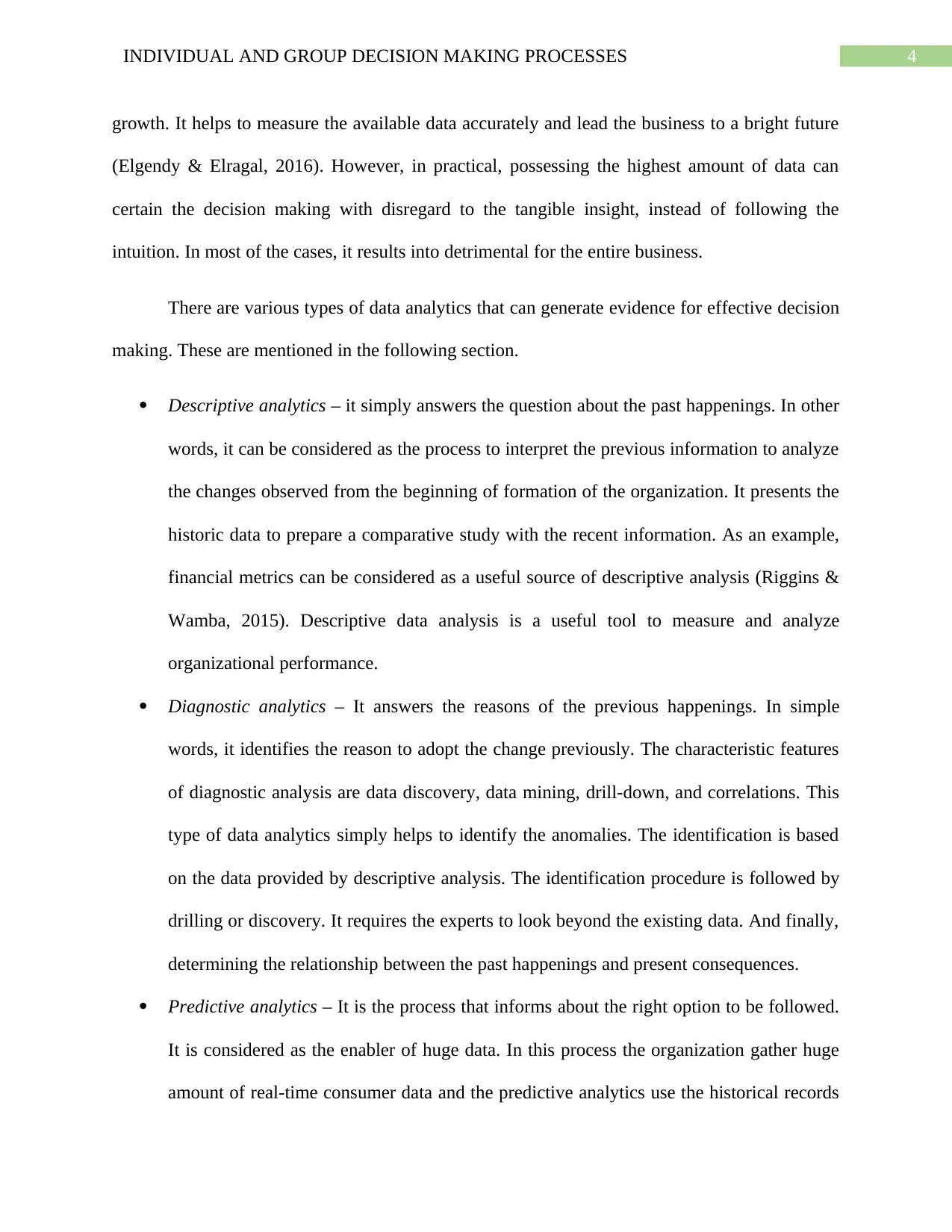
4INDIVIDUAL AND GROUP DECISION MAKING PROCESSES
growth. It helps to measure the available data accurately and lead the business to a bright future
(Elgendy & Elragal, 2016). However, in practical, possessing the highest amount of data can
certain the decision making with disregard to the tangible insight, instead of following the
intuition. In most of the cases, it results into detrimental for the entire business.
There are various types of data analytics that can generate evidence for effective decision
making. These are mentioned in the following section.
Descriptive analytics – it simply answers the question about the past happenings. In other
words, it can be considered as the process to interpret the previous information to analyze
the changes observed from the beginning of formation of the organization. It presents the
historic data to prepare a comparative study with the recent information. As an example,
financial metrics can be considered as a useful source of descriptive analysis (Riggins &
Wamba, 2015). Descriptive data analysis is a useful tool to measure and analyze
organizational performance.
Diagnostic analytics – It answers the reasons of the previous happenings. In simple
words, it identifies the reason to adopt the change previously. The characteristic features
of diagnostic analysis are data discovery, data mining, drill-down, and correlations. This
type of data analytics simply helps to identify the anomalies. The identification is based
on the data provided by descriptive analysis. The identification procedure is followed by
drilling or discovery. It requires the experts to look beyond the existing data. And finally,
determining the relationship between the past happenings and present consequences.
Predictive analytics – It is the process that informs about the right option to be followed.
It is considered as the enabler of huge data. In this process the organization gather huge
amount of real-time consumer data and the predictive analytics use the historical records
growth. It helps to measure the available data accurately and lead the business to a bright future
(Elgendy & Elragal, 2016). However, in practical, possessing the highest amount of data can
certain the decision making with disregard to the tangible insight, instead of following the
intuition. In most of the cases, it results into detrimental for the entire business.
There are various types of data analytics that can generate evidence for effective decision
making. These are mentioned in the following section.
Descriptive analytics – it simply answers the question about the past happenings. In other
words, it can be considered as the process to interpret the previous information to analyze
the changes observed from the beginning of formation of the organization. It presents the
historic data to prepare a comparative study with the recent information. As an example,
financial metrics can be considered as a useful source of descriptive analysis (Riggins &
Wamba, 2015). Descriptive data analysis is a useful tool to measure and analyze
organizational performance.
Diagnostic analytics – It answers the reasons of the previous happenings. In simple
words, it identifies the reason to adopt the change previously. The characteristic features
of diagnostic analysis are data discovery, data mining, drill-down, and correlations. This
type of data analytics simply helps to identify the anomalies. The identification is based
on the data provided by descriptive analysis. The identification procedure is followed by
drilling or discovery. It requires the experts to look beyond the existing data. And finally,
determining the relationship between the past happenings and present consequences.
Predictive analytics – It is the process that informs about the right option to be followed.
It is considered as the enabler of huge data. In this process the organization gather huge
amount of real-time consumer data and the predictive analytics use the historical records
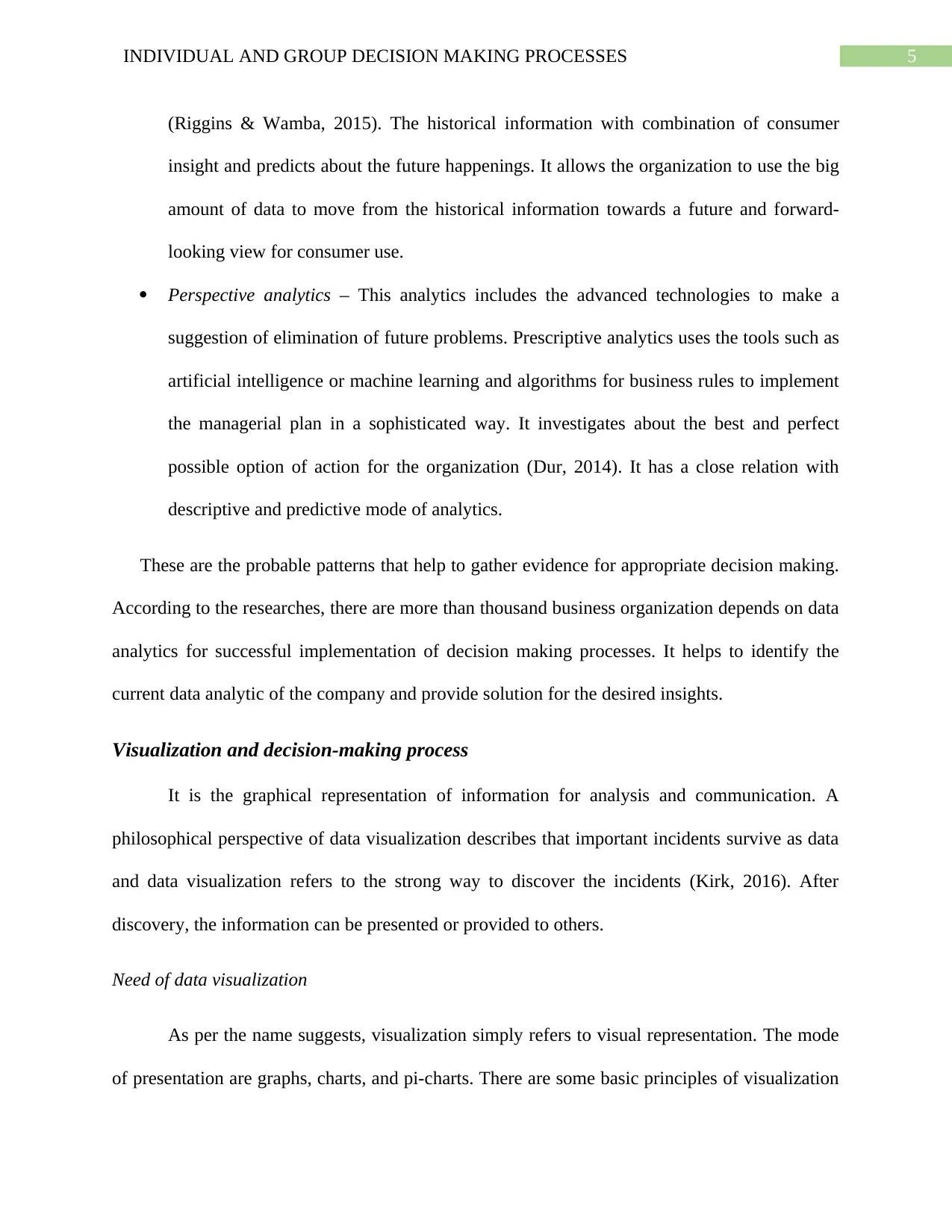
5INDIVIDUAL AND GROUP DECISION MAKING PROCESSES
(Riggins & Wamba, 2015). The historical information with combination of consumer
insight and predicts about the future happenings. It allows the organization to use the big
amount of data to move from the historical information towards a future and forward-
looking view for consumer use.
Perspective analytics – This analytics includes the advanced technologies to make a
suggestion of elimination of future problems. Prescriptive analytics uses the tools such as
artificial intelligence or machine learning and algorithms for business rules to implement
the managerial plan in a sophisticated way. It investigates about the best and perfect
possible option of action for the organization (Dur, 2014). It has a close relation with
descriptive and predictive mode of analytics.
These are the probable patterns that help to gather evidence for appropriate decision making.
According to the researches, there are more than thousand business organization depends on data
analytics for successful implementation of decision making processes. It helps to identify the
current data analytic of the company and provide solution for the desired insights.
Visualization and decision-making process
It is the graphical representation of information for analysis and communication. A
philosophical perspective of data visualization describes that important incidents survive as data
and data visualization refers to the strong way to discover the incidents (Kirk, 2016). After
discovery, the information can be presented or provided to others.
Need of data visualization
As per the name suggests, visualization simply refers to visual representation. The mode
of presentation are graphs, charts, and pi-charts. There are some basic principles of visualization
(Riggins & Wamba, 2015). The historical information with combination of consumer
insight and predicts about the future happenings. It allows the organization to use the big
amount of data to move from the historical information towards a future and forward-
looking view for consumer use.
Perspective analytics – This analytics includes the advanced technologies to make a
suggestion of elimination of future problems. Prescriptive analytics uses the tools such as
artificial intelligence or machine learning and algorithms for business rules to implement
the managerial plan in a sophisticated way. It investigates about the best and perfect
possible option of action for the organization (Dur, 2014). It has a close relation with
descriptive and predictive mode of analytics.
These are the probable patterns that help to gather evidence for appropriate decision making.
According to the researches, there are more than thousand business organization depends on data
analytics for successful implementation of decision making processes. It helps to identify the
current data analytic of the company and provide solution for the desired insights.
Visualization and decision-making process
It is the graphical representation of information for analysis and communication. A
philosophical perspective of data visualization describes that important incidents survive as data
and data visualization refers to the strong way to discover the incidents (Kirk, 2016). After
discovery, the information can be presented or provided to others.
Need of data visualization
As per the name suggests, visualization simply refers to visual representation. The mode
of presentation are graphs, charts, and pi-charts. There are some basic principles of visualization
⊘ This is a preview!⊘
Do you want full access?
Subscribe today to unlock all pages.

Trusted by 1+ million students worldwide

6INDIVIDUAL AND GROUP DECISION MAKING PROCESSES
followed by the researchers. Visualization is important to take any large scale decision. It can be
helpful for individual decision also. For instance, visualization can be applied to determine
whether to evacuate the entire organization before any climate hazards. It can be used in making
individual decision of selection of right treatment for medicinal benefit (Juarez et al., 2015). In
spite of the existing benefits of visualization in decision-making, there are certain obstacles
associated with the relation of visualization and decision making.
It is worth mentioning in this regard, the presentation related to visualization is only the
external information. According to the psychological study, human being retain more than 80%
of what can be seen. Contrarily, they can retain not more than 20% of what they can read or hear.
From this study, it is easy to determine which appropriate is suitable for the huge responsibility
of decision-making. Visualization provides faster response within particular time frame
(Grainger, Mao & Buytaert, 2016). Business personnel including sales manager, directors,
marketing managers, and service representatives require to manage huge amount of data on a
daily basis. Graphical presentation helps them to draw faster impression from the data and make
decision accordingly.
Visual presentation deals with advanced technology. Companies collect different types of
information from the consumer forum and the organizations on a daily basis. Visual presentation
keeps the record simple. The procedure of visualization provides a big picture with detailed and
picture representation of the data. It provides a pattern for effective decision making. The
presentation displays the data in real time (Juarez et al., 2015). All the departments of the
organization can easily get access to progress their effort and collaborative spirit. Combining all
the benefits of data visualization, it can be said that, it has a positive impact on the business
development. Among all the available mode of conveying the information, employees exhibit
followed by the researchers. Visualization is important to take any large scale decision. It can be
helpful for individual decision also. For instance, visualization can be applied to determine
whether to evacuate the entire organization before any climate hazards. It can be used in making
individual decision of selection of right treatment for medicinal benefit (Juarez et al., 2015). In
spite of the existing benefits of visualization in decision-making, there are certain obstacles
associated with the relation of visualization and decision making.
It is worth mentioning in this regard, the presentation related to visualization is only the
external information. According to the psychological study, human being retain more than 80%
of what can be seen. Contrarily, they can retain not more than 20% of what they can read or hear.
From this study, it is easy to determine which appropriate is suitable for the huge responsibility
of decision-making. Visualization provides faster response within particular time frame
(Grainger, Mao & Buytaert, 2016). Business personnel including sales manager, directors,
marketing managers, and service representatives require to manage huge amount of data on a
daily basis. Graphical presentation helps them to draw faster impression from the data and make
decision accordingly.
Visual presentation deals with advanced technology. Companies collect different types of
information from the consumer forum and the organizations on a daily basis. Visual presentation
keeps the record simple. The procedure of visualization provides a big picture with detailed and
picture representation of the data. It provides a pattern for effective decision making. The
presentation displays the data in real time (Juarez et al., 2015). All the departments of the
organization can easily get access to progress their effort and collaborative spirit. Combining all
the benefits of data visualization, it can be said that, it has a positive impact on the business
development. Among all the available mode of conveying the information, employees exhibit
Paraphrase This Document
Need a fresh take? Get an instant paraphrase of this document with our AI Paraphraser
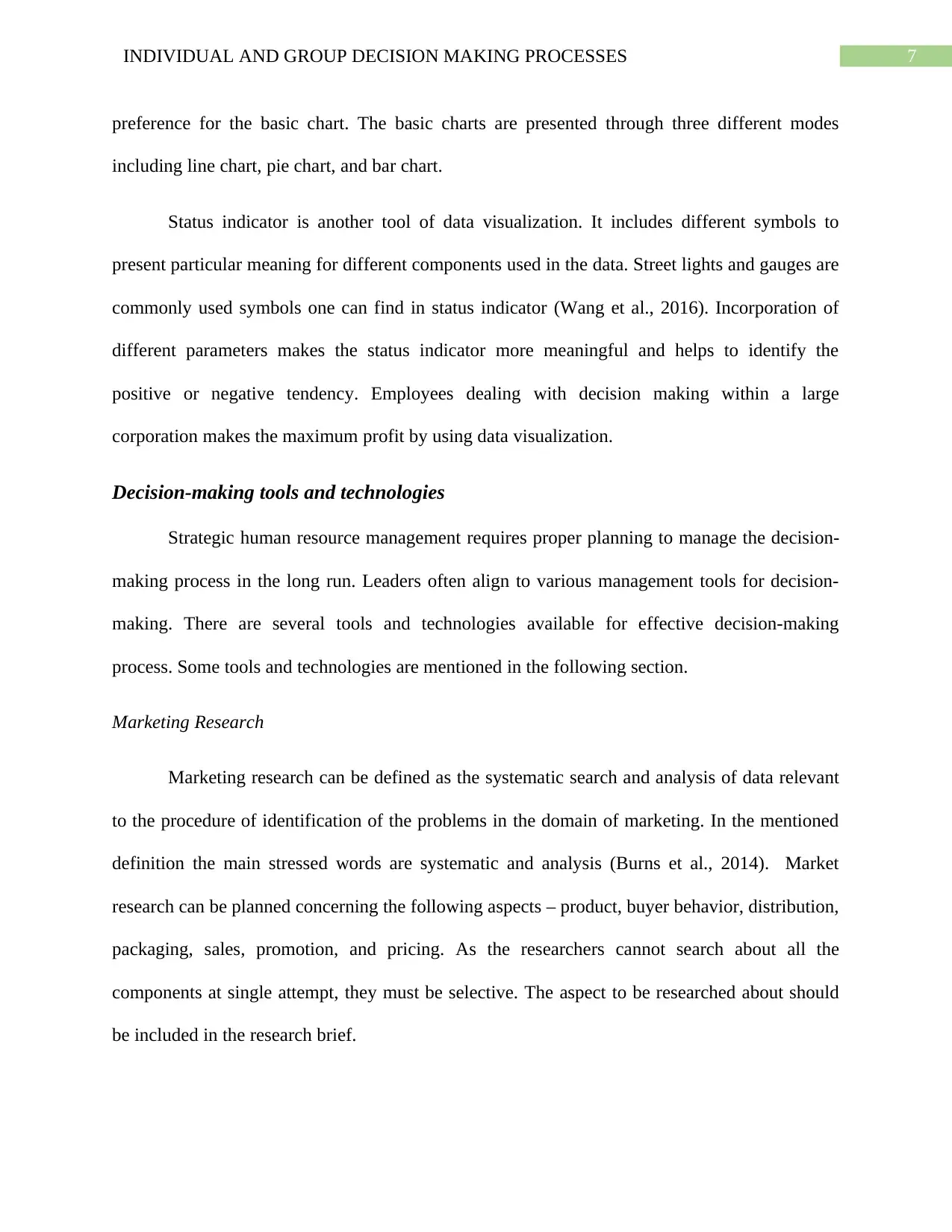
7INDIVIDUAL AND GROUP DECISION MAKING PROCESSES
preference for the basic chart. The basic charts are presented through three different modes
including line chart, pie chart, and bar chart.
Status indicator is another tool of data visualization. It includes different symbols to
present particular meaning for different components used in the data. Street lights and gauges are
commonly used symbols one can find in status indicator (Wang et al., 2016). Incorporation of
different parameters makes the status indicator more meaningful and helps to identify the
positive or negative tendency. Employees dealing with decision making within a large
corporation makes the maximum profit by using data visualization.
Decision-making tools and technologies
Strategic human resource management requires proper planning to manage the decision-
making process in the long run. Leaders often align to various management tools for decision-
making. There are several tools and technologies available for effective decision-making
process. Some tools and technologies are mentioned in the following section.
Marketing Research
Marketing research can be defined as the systematic search and analysis of data relevant
to the procedure of identification of the problems in the domain of marketing. In the mentioned
definition the main stressed words are systematic and analysis (Burns et al., 2014). Market
research can be planned concerning the following aspects – product, buyer behavior, distribution,
packaging, sales, promotion, and pricing. As the researchers cannot search about all the
components at single attempt, they must be selective. The aspect to be researched about should
be included in the research brief.
preference for the basic chart. The basic charts are presented through three different modes
including line chart, pie chart, and bar chart.
Status indicator is another tool of data visualization. It includes different symbols to
present particular meaning for different components used in the data. Street lights and gauges are
commonly used symbols one can find in status indicator (Wang et al., 2016). Incorporation of
different parameters makes the status indicator more meaningful and helps to identify the
positive or negative tendency. Employees dealing with decision making within a large
corporation makes the maximum profit by using data visualization.
Decision-making tools and technologies
Strategic human resource management requires proper planning to manage the decision-
making process in the long run. Leaders often align to various management tools for decision-
making. There are several tools and technologies available for effective decision-making
process. Some tools and technologies are mentioned in the following section.
Marketing Research
Marketing research can be defined as the systematic search and analysis of data relevant
to the procedure of identification of the problems in the domain of marketing. In the mentioned
definition the main stressed words are systematic and analysis (Burns et al., 2014). Market
research can be planned concerning the following aspects – product, buyer behavior, distribution,
packaging, sales, promotion, and pricing. As the researchers cannot search about all the
components at single attempt, they must be selective. The aspect to be researched about should
be included in the research brief.
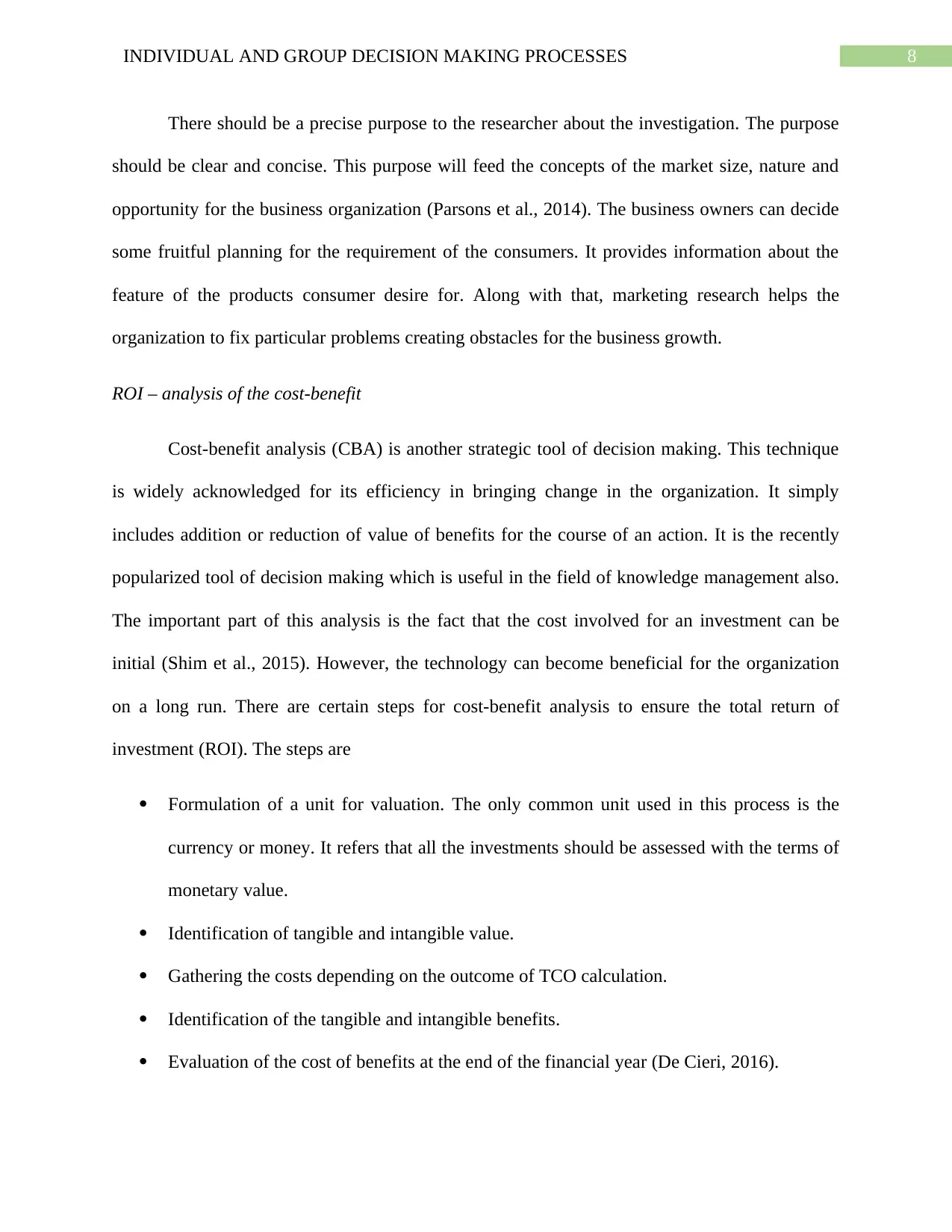
8INDIVIDUAL AND GROUP DECISION MAKING PROCESSES
There should be a precise purpose to the researcher about the investigation. The purpose
should be clear and concise. This purpose will feed the concepts of the market size, nature and
opportunity for the business organization (Parsons et al., 2014). The business owners can decide
some fruitful planning for the requirement of the consumers. It provides information about the
feature of the products consumer desire for. Along with that, marketing research helps the
organization to fix particular problems creating obstacles for the business growth.
ROI – analysis of the cost-benefit
Cost-benefit analysis (CBA) is another strategic tool of decision making. This technique
is widely acknowledged for its efficiency in bringing change in the organization. It simply
includes addition or reduction of value of benefits for the course of an action. It is the recently
popularized tool of decision making which is useful in the field of knowledge management also.
The important part of this analysis is the fact that the cost involved for an investment can be
initial (Shim et al., 2015). However, the technology can become beneficial for the organization
on a long run. There are certain steps for cost-benefit analysis to ensure the total return of
investment (ROI). The steps are
Formulation of a unit for valuation. The only common unit used in this process is the
currency or money. It refers that all the investments should be assessed with the terms of
monetary value.
Identification of tangible and intangible value.
Gathering the costs depending on the outcome of TCO calculation.
Identification of the tangible and intangible benefits.
Evaluation of the cost of benefits at the end of the financial year (De Cieri, 2016).
There should be a precise purpose to the researcher about the investigation. The purpose
should be clear and concise. This purpose will feed the concepts of the market size, nature and
opportunity for the business organization (Parsons et al., 2014). The business owners can decide
some fruitful planning for the requirement of the consumers. It provides information about the
feature of the products consumer desire for. Along with that, marketing research helps the
organization to fix particular problems creating obstacles for the business growth.
ROI – analysis of the cost-benefit
Cost-benefit analysis (CBA) is another strategic tool of decision making. This technique
is widely acknowledged for its efficiency in bringing change in the organization. It simply
includes addition or reduction of value of benefits for the course of an action. It is the recently
popularized tool of decision making which is useful in the field of knowledge management also.
The important part of this analysis is the fact that the cost involved for an investment can be
initial (Shim et al., 2015). However, the technology can become beneficial for the organization
on a long run. There are certain steps for cost-benefit analysis to ensure the total return of
investment (ROI). The steps are
Formulation of a unit for valuation. The only common unit used in this process is the
currency or money. It refers that all the investments should be assessed with the terms of
monetary value.
Identification of tangible and intangible value.
Gathering the costs depending on the outcome of TCO calculation.
Identification of the tangible and intangible benefits.
Evaluation of the cost of benefits at the end of the financial year (De Cieri, 2016).
⊘ This is a preview!⊘
Do you want full access?
Subscribe today to unlock all pages.

Trusted by 1+ million students worldwide
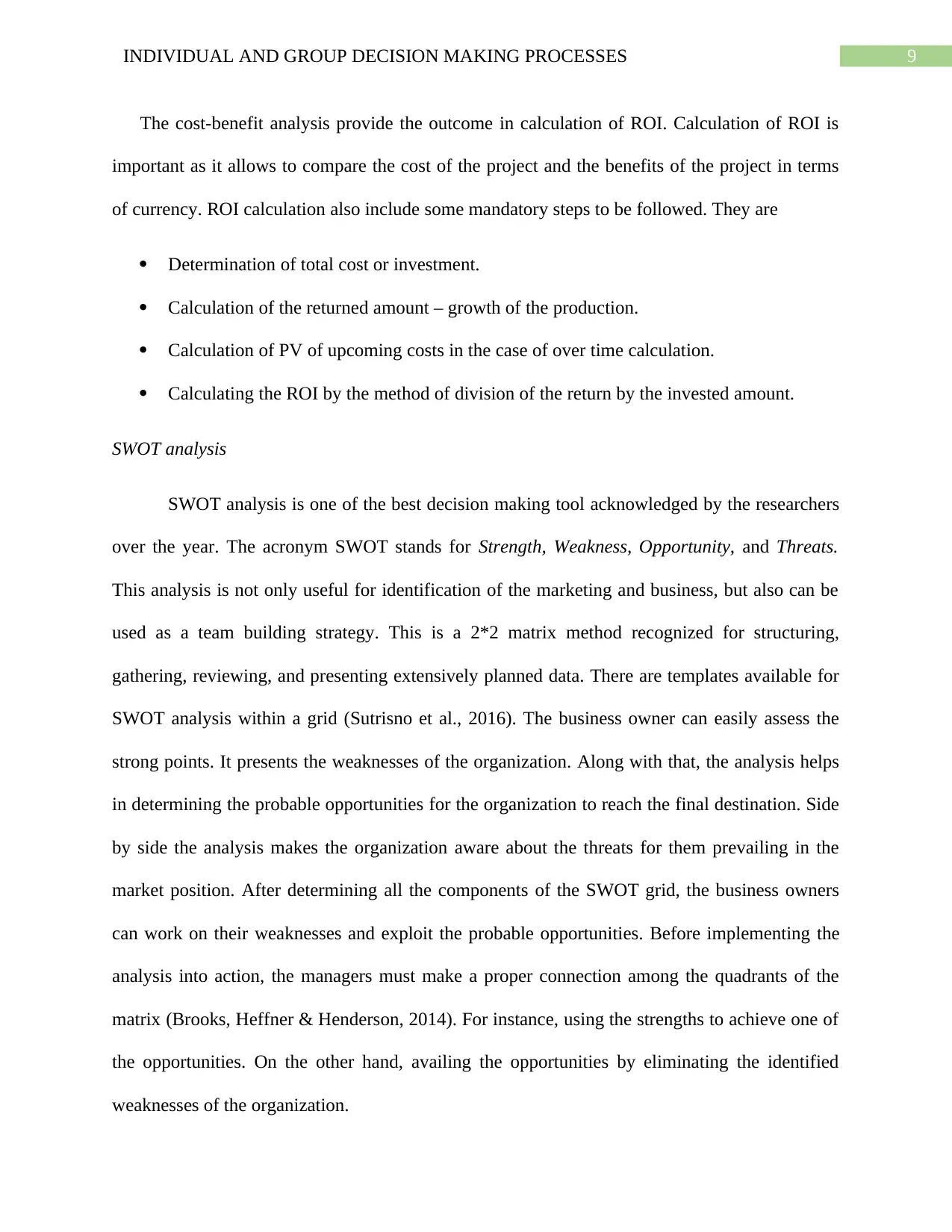
9INDIVIDUAL AND GROUP DECISION MAKING PROCESSES
The cost-benefit analysis provide the outcome in calculation of ROI. Calculation of ROI is
important as it allows to compare the cost of the project and the benefits of the project in terms
of currency. ROI calculation also include some mandatory steps to be followed. They are
Determination of total cost or investment.
Calculation of the returned amount – growth of the production.
Calculation of PV of upcoming costs in the case of over time calculation.
Calculating the ROI by the method of division of the return by the invested amount.
SWOT analysis
SWOT analysis is one of the best decision making tool acknowledged by the researchers
over the year. The acronym SWOT stands for Strength, Weakness, Opportunity, and Threats.
This analysis is not only useful for identification of the marketing and business, but also can be
used as a team building strategy. This is a 2*2 matrix method recognized for structuring,
gathering, reviewing, and presenting extensively planned data. There are templates available for
SWOT analysis within a grid (Sutrisno et al., 2016). The business owner can easily assess the
strong points. It presents the weaknesses of the organization. Along with that, the analysis helps
in determining the probable opportunities for the organization to reach the final destination. Side
by side the analysis makes the organization aware about the threats for them prevailing in the
market position. After determining all the components of the SWOT grid, the business owners
can work on their weaknesses and exploit the probable opportunities. Before implementing the
analysis into action, the managers must make a proper connection among the quadrants of the
matrix (Brooks, Heffner & Henderson, 2014). For instance, using the strengths to achieve one of
the opportunities. On the other hand, availing the opportunities by eliminating the identified
weaknesses of the organization.
The cost-benefit analysis provide the outcome in calculation of ROI. Calculation of ROI is
important as it allows to compare the cost of the project and the benefits of the project in terms
of currency. ROI calculation also include some mandatory steps to be followed. They are
Determination of total cost or investment.
Calculation of the returned amount – growth of the production.
Calculation of PV of upcoming costs in the case of over time calculation.
Calculating the ROI by the method of division of the return by the invested amount.
SWOT analysis
SWOT analysis is one of the best decision making tool acknowledged by the researchers
over the year. The acronym SWOT stands for Strength, Weakness, Opportunity, and Threats.
This analysis is not only useful for identification of the marketing and business, but also can be
used as a team building strategy. This is a 2*2 matrix method recognized for structuring,
gathering, reviewing, and presenting extensively planned data. There are templates available for
SWOT analysis within a grid (Sutrisno et al., 2016). The business owner can easily assess the
strong points. It presents the weaknesses of the organization. Along with that, the analysis helps
in determining the probable opportunities for the organization to reach the final destination. Side
by side the analysis makes the organization aware about the threats for them prevailing in the
market position. After determining all the components of the SWOT grid, the business owners
can work on their weaknesses and exploit the probable opportunities. Before implementing the
analysis into action, the managers must make a proper connection among the quadrants of the
matrix (Brooks, Heffner & Henderson, 2014). For instance, using the strengths to achieve one of
the opportunities. On the other hand, availing the opportunities by eliminating the identified
weaknesses of the organization.
Paraphrase This Document
Need a fresh take? Get an instant paraphrase of this document with our AI Paraphraser

10INDIVIDUAL AND GROUP DECISION MAKING PROCESSES
These are the commonly used tools and techniques to effectively implement decision
making processes between the organizations. Apart from these, there are various tools that can be
effective for decision making such as – study of feasibility. Overall it is worth mentioning that,
decision making is a crucial part of each and every department of the organization. Decision
making is categorized in programmed and non-programmed dimensions. Programmed decisions
are the guidelines or the rulebook for each employee of the organization. All the employees need
to abide by these rules to survive in the organization. Non-programmed decisions are
consequential.
Conclusion
In conclusion, it can be said that decision making is an inevitable procedure connected
with all the sections of the organization. It determines the success or failure of the organization.
An efficient decision making procedure should include the following steps.
Goal identification – There should be a motto of every urgency of decision making.
Proper alignment of consumers, organizational vision, and stakeholders should be
incorporated with the procedure of goal identification.
Data collection – Collecting important information to determine the course of action with
identification of proper alternatives.
Evaluating the alternatives – The situation will present various right option to be taken
for the organization. This step includes the evaluation of all the available alternatives to
make the right decision.
Selection – Evaluation is followed by selection of the right option. This is the time to take
the right decision for the organization.
Evaluation – The final step is to evaluate the taken decision to measure its efficiency.
These are the commonly used tools and techniques to effectively implement decision
making processes between the organizations. Apart from these, there are various tools that can be
effective for decision making such as – study of feasibility. Overall it is worth mentioning that,
decision making is a crucial part of each and every department of the organization. Decision
making is categorized in programmed and non-programmed dimensions. Programmed decisions
are the guidelines or the rulebook for each employee of the organization. All the employees need
to abide by these rules to survive in the organization. Non-programmed decisions are
consequential.
Conclusion
In conclusion, it can be said that decision making is an inevitable procedure connected
with all the sections of the organization. It determines the success or failure of the organization.
An efficient decision making procedure should include the following steps.
Goal identification – There should be a motto of every urgency of decision making.
Proper alignment of consumers, organizational vision, and stakeholders should be
incorporated with the procedure of goal identification.
Data collection – Collecting important information to determine the course of action with
identification of proper alternatives.
Evaluating the alternatives – The situation will present various right option to be taken
for the organization. This step includes the evaluation of all the available alternatives to
make the right decision.
Selection – Evaluation is followed by selection of the right option. This is the time to take
the right decision for the organization.
Evaluation – The final step is to evaluate the taken decision to measure its efficiency.

11INDIVIDUAL AND GROUP DECISION MAKING PROCESSES
As mentioned there are enormous tools and techniques available for fruitful implementation
of decision making processes in the organization. Apart from market research, SWOT analysis,
and ROI, there are techniques such as decision matrix, t-chart, decision tree, conjoint analysis,
and PEST analysis. However, these techniques are not free of criticisms. An inevitable fact about
decision making is, it can guide the organization by fallacies with the outcome of intuitional
decisions.
As mentioned there are enormous tools and techniques available for fruitful implementation
of decision making processes in the organization. Apart from market research, SWOT analysis,
and ROI, there are techniques such as decision matrix, t-chart, decision tree, conjoint analysis,
and PEST analysis. However, these techniques are not free of criticisms. An inevitable fact about
decision making is, it can guide the organization by fallacies with the outcome of intuitional
decisions.
⊘ This is a preview!⊘
Do you want full access?
Subscribe today to unlock all pages.

Trusted by 1+ million students worldwide
1 out of 15
Related Documents
Your All-in-One AI-Powered Toolkit for Academic Success.
+13062052269
info@desklib.com
Available 24*7 on WhatsApp / Email
![[object Object]](/_next/static/media/star-bottom.7253800d.svg)
Unlock your academic potential
Copyright © 2020–2025 A2Z Services. All Rights Reserved. Developed and managed by ZUCOL.





